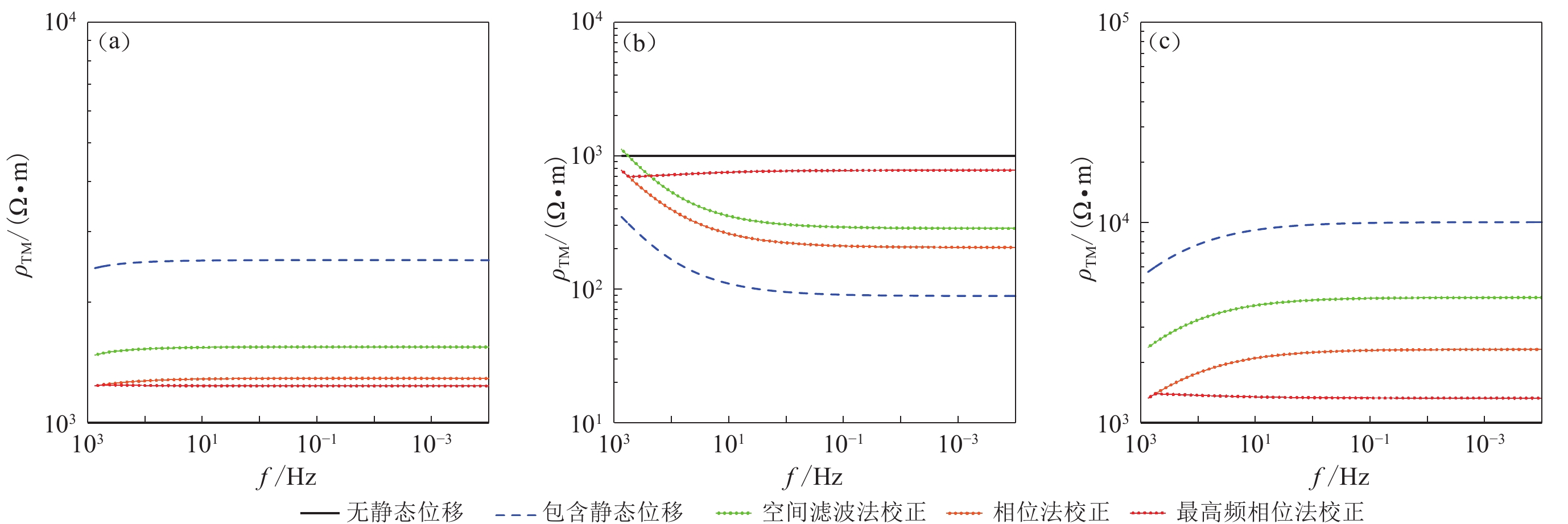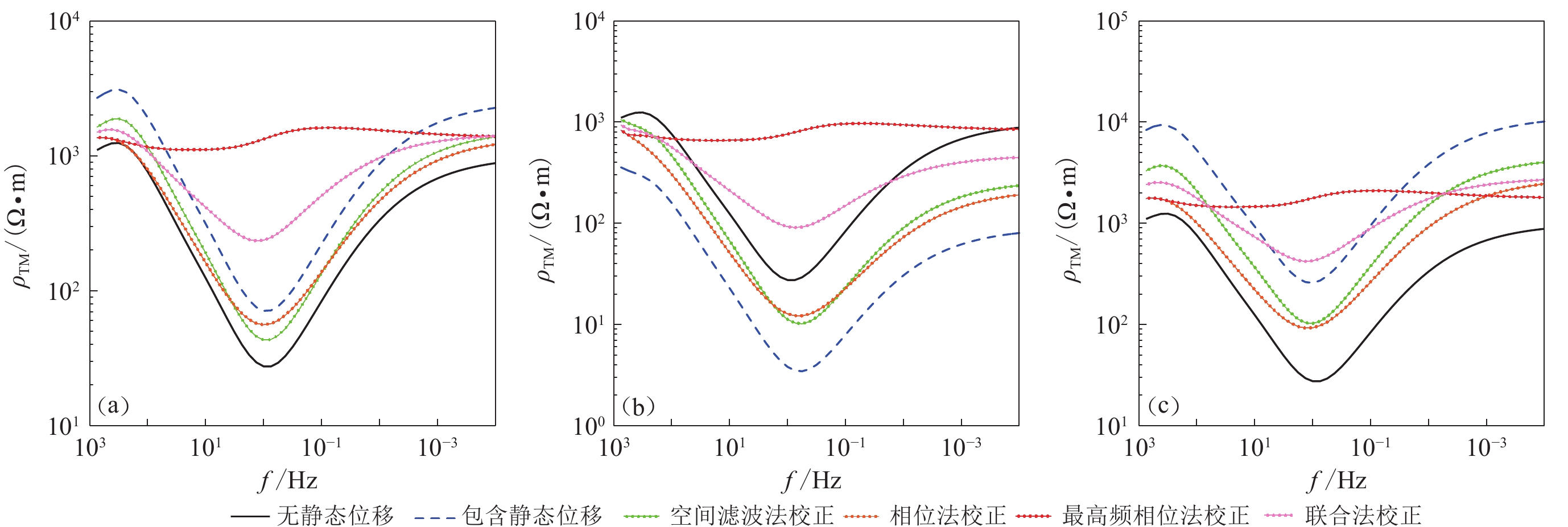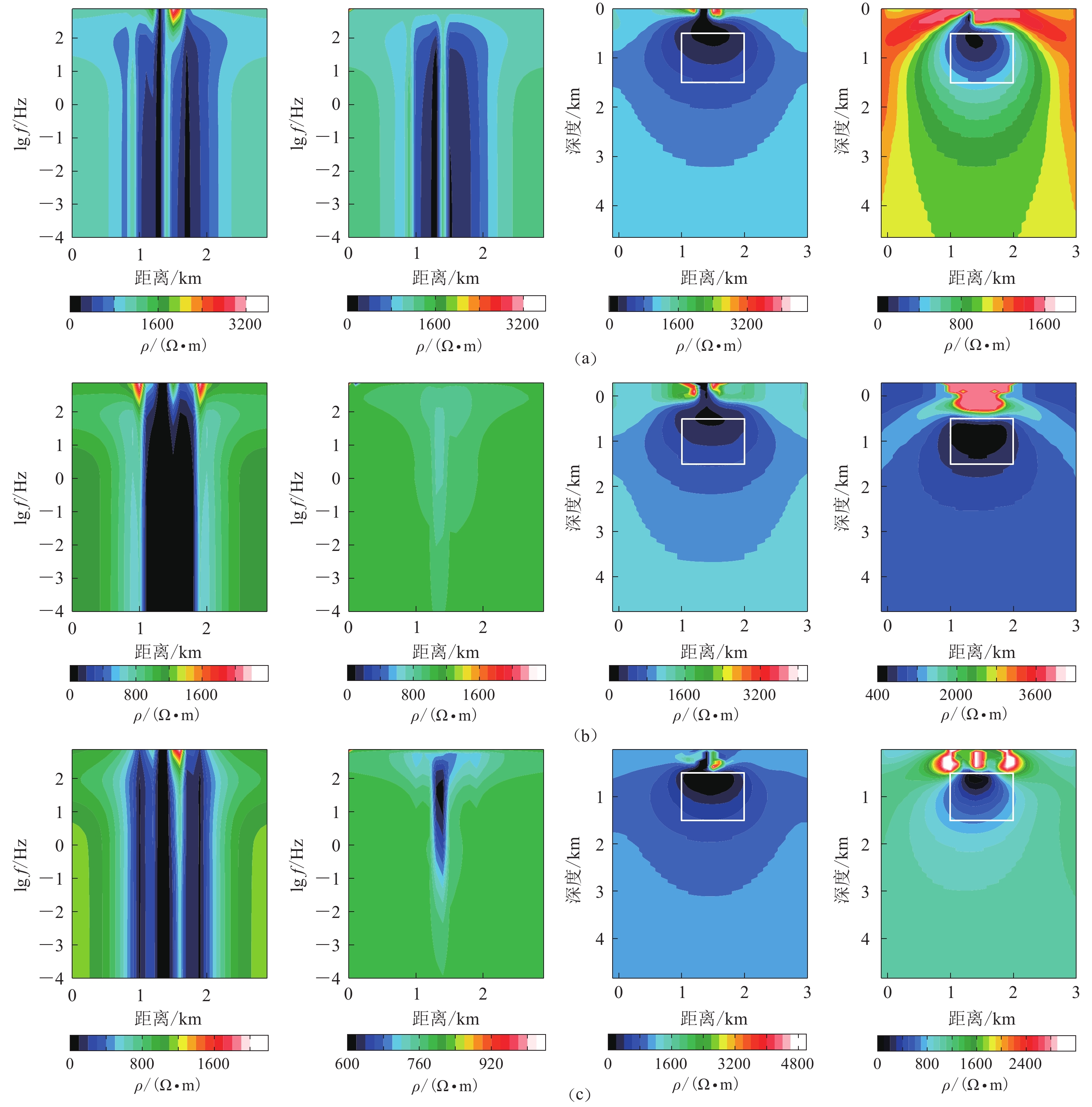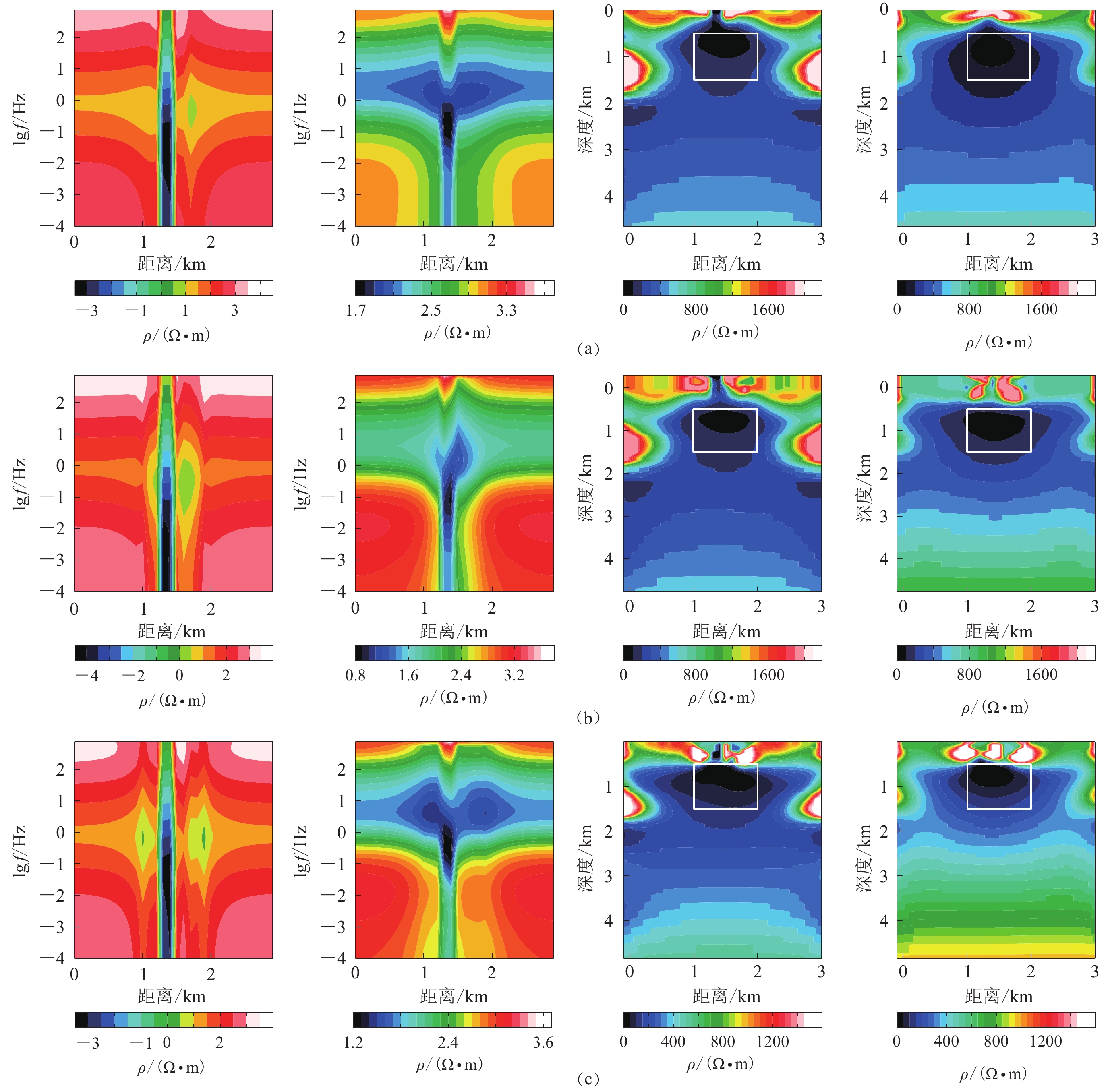Magnetotelluric static correction of two-dimensional model based on the highest frequency phase method and spatial filtering method
-
摘要: 静态效应一直是影响大地电磁测深法精确性的主要原因之一。在相位校正法的基础上提出了一种更适用于电性变化较为平缓的地质情况的静态校正方法—最高频相位法,其核心是用需要校正测点两侧受静态效应影响较小测点的最高频视电阻率的算术平均值代替相位法递推公式中每个频点前一个频点的视电阻率值,以消除相位法中的误差积累。以二维模型的正反演为例,通过对比空间滤波法、相位法和最高频相位法对不同模型静态校正前后的正反演结果,证明了最高频相位法的有效性和优越性,同时表明,对于电阻率变化大并且静态位移严重的水平层状地层模型,采用与空间滤波法相结合的联合校正效果更佳。Abstract: Static effect is one of the main reasons for affecting the accuracy of magnetotelluric sounding. In this paper, a static correction method, the highest frequency phase method, is proposed on the basis of the phase correction method, which is more suitable for geological conditions with smooth electrical changes. Its principle is to eliminate the error accumulation in the phase correction method by replacing the apparent resistivity value of the previous frequency point in the recurrence formula with the arithmetic mean of the highest frequency apparent resistivity of the measuring points on both sides of the measuring points that need to be corrected and are less affected by the static effect. Taking the forward and inversion of two-dimensional model as an example, the effectiveness and superiority of the highest frequency phase method are proved by comparing the forward and inversion results from spatial filtering method, phase correction method and highest frequency phase method before and after static correction for different models. It also shows that for the horizontal layered formation model with sharp resistivity difference and severe static shift, the static correction effect of joint correction which combines highest frequency phase method with spatial filtering method is much better.
-
引言
黄土在我国分布广泛,黄土高原为其主要分布区。与其它土类相比,黄土自身特有的架空孔隙和弱胶结结构使之具有水敏性和动力易损性。大量震害现场调查资料显示,黄土高原地区在中强震作用下发生滑坡灾害的风险较高,且由地震诱发的滑坡往往具有规模大、滑速快、滑程远、致灾性强等特点,因此,一旦发生就会造成严重的人员伤亡和经济损失。
地震诱发滑坡的本质是由于地震波作用于斜坡,使斜坡坡体由静止状态转为运动状态,剧烈振动引起岩土体结构松动、变形,从而产生滑动面上下贯通,滑面上部坡体与下部坡体产生相对运动,造成宏观上失稳破坏的一种现象。天然地震波包含的频段众多,虽然任何频率的地震动都会使坡体产生振动,但输入地震动频率与岩土体固有频率接近或相同时,在共振作用下地震动将被放大数倍甚至几十倍(刘汉香等,2014),从而使得斜坡坡体受到的应力和产生的位移变形增加,滑坡发生的几率也随之增大。
对众多地震滑坡震害现象的实际调查和理论试验研究表明,地震动三要素(幅值、频谱和持时)的组合决定了地震作用下边坡等岩土体的受灾程度(胡聿贤等,1981;祁生文等,2003;徐光兴等,2008;黄润秋,2009;殷跃平,2009)。由于地震动频谱的获取较地震动幅值和持时复杂,因此针对地震动频谱对斜坡动力响应的研究并不充分。已有研究表明,输入不同频谱的地震动对斜坡稳定性的影响显著。刘红帅(2006)通过基于显式波动有限元极限平衡法证实了地震动频谱特性对边坡稳定性有一定影响;徐光兴等(2008)利用FLAC3D(fast lagrangian analysis of continua)的计算表明边坡土体对输入地震波低频部分存在放大作用,对高频部分具有滤波作用。张江伟等(2017)分析了不同地震动作用下边坡模型的加速度和位移响应,结果显示当输入地震动特征周期大于0.65 s时,坡体位移响应明显增大,同时坡顶的峰值加速度放大系数也呈增大趋势;施艳秋等(2020)基于大型振动台实验,利用小波包分析方法将动土压力时域曲线分解显示,低频波在动土压力响应中起主导作用,边坡对地震波沿高程运动过程中的高频部分具有“滤波作用”;武志信等(2020)通过大型振动台试验,利用小波包分析工具对滑面附近位置处的动土压力曲线进行分解,证实对动土压力具有影响作用的主要为低频地震波;常晁瑜(2022)基于离散元分析软件(particle flow code,缩写为PFC)模拟了黄土地震滑坡的破坏失稳过程,证实了低频震动对滑坡的破坏作用更强,破坏后,坡面震动的高频成分有所增加。
上述研究可以看出,地震动频谱对地震滑坡的失稳破坏的影响尚不充分,未形成共识,针对黄土地震滑坡的研究更少。因此,本文基于野外调查和室内试验,概化地形模型,拟通过数值模拟分析的方法,探究造成斜坡失稳破坏的主要频段,并提出针对性的防治手段,以减轻地震滑坡灾害。
1. 方法和模型
1.1 计算软件
FLAC3D 是解决岩土大变形问题的一种常用模拟分析软件,它以连续介质作为基本假设,利用差分方式以时间步积分求解,该软件采用动态运动方程,使其在不稳定的模拟过程中不存在数值上的障碍;计算时采用“显式解”方案,对非线性应力−应变关系花费的求解时间较短;采用“混合离散法”模拟材料塑形破坏和塑性流动,计算结果较为精确(周永利,2009)。众多学者利用FLAC3D软件探究滑坡问题,韩万东等(2013)利用FLAC3D建立边坡数值模型,基于强度折减理论进行数值模拟,揭示滑坡机理,验证极限平衡法的准确性;付雪等(2021)利用FLAC3D模拟土体、岩体或其它材料力学特性,对土质边坡进行了稳定性分析。鉴于FLAC3D的上述优势,本文选用FLAC3D作为模拟分析软件。
1.2 模型建立
根据西吉、海原和固原地区的黄土地形地貌和地质条件,建立概化模型,模型共分为3层:底层片麻岩作为基底,中间层为泥岩,覆盖层为黄土,黄土厚度为20 m。斜坡长280 m,高105 m。每层土体视为各向同性,并采用Mohr-Coulomb材料模型,根据模型所在地质结构特征及岩土体的物理力学性质情况,结合大量土工实验结果(乔峰等,2021),综合得到建模相关参数如表1所示,简化模型如图1所示。同时为了研究地震动频谱对黄土斜坡稳定的影响,需设置合适的监测点,监测点位置分布见图1。
表 1 本文研究所用的模型参数Table 1. Model parameters used in this study分层 岩性 密度/
(g·cm−3)体积模量
/MPa剪切
模量/MPa黏聚力
/kPa内摩擦
角/°基层 片麻岩 2.8 138 133 350 54 中间层 泥岩 2.2 73 51 120 40 覆盖层 黄土 1.8 18 20 45 17 1.3 边界条件的设置
在静力分析中,采用固定边界来约束模型的四周和底面,把模型的顶面设置为自由边界; 在动力分析中,为减少地震波在模型中的反射对模拟结果的影响,在模型四周设置自由场边界,模型底部施加静态边界(黏性边界)。
FLAC3D中采用的静态边界是由Lysmer和Kuhlemeyer (1969)提出的黏性边界。它是基于在模型边界的法向和剪切方向上使用独立的阻尼器进行能量吸收,阻尼器提供的法向tn和剪切黏性力ts分别为:
$$ \mathit{t} _{ \mathrm{n}} \mathit{=-\rho C} _{ \mathrm{P}} \mathit{v} _{ \mathrm{n}} \text{,} $$ (1) $$ \mathit{t} _{ \mathrm{s}} \mathit= \mathrm- \mathit{\rho C} _{ \mathrm{S}} \mathit{v} _{ {{\mathrm{s}}} } \mathrm{\text{,}} $$ (2) 式中: ρ为岩体密度,CP和CS分别为P波和S波的波速,vn和 vs分别为边界上的法向和切向速度分量。
1.4 静力平衡
在FLAC3D中,动力分析建立在静力分析的基础上。对模型先进行静力平衡,只有得到正确的初始地应力场才能开展后续计算(刘春玲等,2004)。此时的数值模拟仅在重力作用下进行,不考虑边界附加应力与构造应力场。使用强度折减法可以判定边坡处于稳定状态(郑颖人等,2010)。
2. 输入地震动处理
为探寻地震动频谱对黄土斜坡失稳破坏的影响,选取阪神地震实际记录的Kobe地震波(NS方向)作为原始地震数据,Kobe波的峰值加速度为0.334 7g,地震动的加速度时程曲线、速度时程曲线、位移时程曲线和对应的傅里叶谱曲线如图2所示。由图可以明显看出,Kobe波主要频率集中在0—10 Hz,利用巴特沃斯(Butterworth)滤波器进行带通滤波,截取频率分别选取0—2 Hz,2—4 Hz,4—6 Hz,6—8 Hz和8—10 Hz,调整滤波后5条加速度时程的幅值,使5条加速度峰值均为0。334 7g,调整后的加速度时程、速度、位移和加速度傅里叶谱如图3所示。
3. 模拟结果分析
为探究地震动频谱对黄土斜坡稳定性的影响,以及不同位置所受的影响,将本文所设监测点1,2,5和2,3,4分为两组,以观察地震动频谱对斜坡坡面和坡体的影响,计算模型同图1。选用地震动频率分别为0—2 Hz,2—4 Hz,4—6 Hz,6—8 Hz和8—10 Hz的地震波作为输入,由于水平方向地震力作用对斜坡的危害远大于垂直方向地震力作用,本文采取水平向地震动输入(罗永红等,2010)。整个运动过程时长为50 s,运行位移云图如图4所示,在FLAC3D中导出各测点最大速度、最大加速度、最大位移时程的数据曲线进行分析(曾惜,2017)。
3.1 地震动频谱对加速度响应的影响
斜坡在输入不同地震频段地震动时,峰值加速度放大系数的变化趋势也不同。此处的加速度峰值放大系数为斜坡上测点处的地震动响应加速度峰值与输入地震动峰值加速度之比。如图5a所示,随坡面高程增加,峰值加速度大致呈先增大后减小的趋势(张沫,2016)。在输入地震动频率为2—4 Hz时,位于坡中位置的测点2其加速度峰值稍低于坡底位置处的测点1,在输入其它频率的地震动时,坡中位置测点的曲线高于坡底位置和坡顶位置。输入地震动频率为8—10 Hz时,坡底位置测点1加速度峰值稍低于坡顶位置测点5,在输入其它频率地震动时,坡顶位置曲线高于坡底位置曲线。坡顶位置和坡底位置峰值加速度放大系数随地震频率的增大而减小,可能是由于振动系统的动态响应导致的。斜坡受到较大地震作用时,动态响应随频率的增大而减小,导致峰值加速度放大系数减小。在输入地震动频率为4—6 Hz时,坡中位置测点2峰值加速度放大系数较输入地震动频率为2—4 Hz情况下大,其原因可能是输入频率和斜坡固有频率相似,引发共振效应所致(刘汉香等,2014)。
如图5b所示,输入不同频率地震动时,随深度的增加加速度峰值放大系数呈不同趋势。在坡体中间位置测点3处,随着输入地震动频率的增大,加速度峰值放大系数呈逐渐增大的趋势,而在坡底部测点4处, 随着输入地震动频率的增大,加速度峰值放大系数呈逐渐减小的趋势。此现象产生的原因可能是由于斜坡坡体动态响应存在差异,斜坡上部振动频率比斜坡坡体底部振动频率更高,因此,斜坡上部动态响应比底部更大,从而导致随地震频率增大,坡体中部加速度峰值放大系数呈逐渐增大趋势,底部加速度峰值放大系数呈逐渐减小趋势。
3.2 地震动频谱对速度响应的影响
斜坡在不同频谱地震动作用下,各监测点的速度变化趋势相同。如图6所示,随输入地震动频率的增大,速度呈现减小趋势,地震动输入频率为0—2 Hz 时,坡体测点的运动速度较输入其它频率值时大。其原因可能是由于斜坡对低频波有较大的放大作用,在输入地震动频率为6—8 Hz和8—10 Hz情况下,测点间的速度值差异均较小,表明高频振动时,斜坡不易发生失稳破坏,斜坡对高频波具有滤波作用。此现象发生还可能是由于斜坡表面受到振动作用时产生了不同摩擦导致,斜坡的振动响应会随频率增大而减小,斜坡所受到的摩擦力增大,从而导致斜坡速度减小。
如图6a所示,坡底位置处的测点1速度最大,坡中位置的测点2与坡顶位置的测点5速度值相差较小,随频率的增大,二者速度曲线接近于重合。水平监测组的三条曲线速度值均相差较小,表明速度受坡面位置影响较小。如图6b所示,当输入地震动的频率为0—2 Hz时,坡面位置测点2的速度值最大,随深度的增加,速度逐渐减小,符合深度效应。其原因可能是由于斜坡地质结构随深度的增加稳定性增强,从而使运动速度减小。输入其它频率地震动时,竖直监测组的三条曲线速度相差较小,表明速度受坡体位置影响较小。
3.3 地震动频谱对位移响应的影响
斜坡在不同地震频谱作用下,各监测点的位移值变化趋势相同,如图7所示,随着输入地震动频率值的增大,位移呈现减小的趋势。表明高频地震动对斜坡运动影响较小,而低频地震动对斜坡运动影响较大,说明土层对较低频率的地震波起到了放大的作用(刘汉香等,2012)。在输入地震动频率为6—8 Hz和8—10 Hz的情况下,测点位移值较小,接近于0,表明低频振动是诱发斜坡失稳的关键频段,而在高频振动下斜坡不易发生失稳破坏,显示出斜坡对高频波“滤波”作用较明显(卢华喜,2007;常晁瑜,2022)。
在水平监测组中(图7a),坡顶位置处的测点5位移量最大,其次是坡中的测点2,位移量最小值为坡底位置的测点1处。在输入地震动频率为0—2 Hz时,可明显看出随着坡面上升,斜坡运动位移增大,并在坡顶处达到最大。而在输入其它频率地震动时,不同高程处测点的位移相差较小,近乎相等,表明位移受坡面高度位置影响较小。如图7b所示,坡面位置处测点2的位移量最大,其次是坡中位置处测点3,位移量最小处为坡底部位置处的测点4。在输入地震动频率为0—2 Hz时,可明显观察到随深度的增加,斜坡运动位移减小。而在输入其它频率地震动时,不同高程测点位移相差较小,近乎相等,表明位移受坡体深度位置影响较小。
4. 讨论与结论
本文基于FLAC3D软件探究频谱对黄土斜坡稳定性影响,通过已知地质条件建立概化模型,输入五种不同频率的地震动,对比水平监测点组和竖直监测点组的加速度峰值放大系数、速度、位移曲线,可得到以下结论:
1) 斜坡加速度受地震动输入频率影响较大,在不同频率地震动输入下,不同监测点加速度峰值放大系数曲线呈现不同变化趋势。同时,速度和位移受地震动输入频率影响较大,各监测点的峰值速度、峰值位移随输入频率变化趋势相同。
2) 斜坡对低频地震波存在放大作用,对高频地震波存在滤波作用;低频振动是诱发斜坡失稳的关键频段,高频振动斜坡不易发生失稳破坏,输入的地震动频率越大,斜坡运动速度和位移越小。
3) 随着高程的增加,斜坡运动位移增大,且地震动输入频率越低,这种增大效果越明显。
本文研究的地震频谱特性对黄土斜坡地震响应的影响可以更好地了解地震动特性,为探究斜坡失稳特性提供参考,同时也可以为评估黄土斜坡稳定性提供依据,从而有效预防山体滑坡等灾害的发生。需特别指出的是,本文所得结论均基于一个概化斜坡模型,未考虑真实情况下斜坡所受诸多方面的影响,具有一定的局限性。斜坡在地震作用下的动力响应是一个十分复杂的过程,地震动频谱对黄土斜坡稳定性的影响还需不断研究。
-
图 1 无地形(a)、含地垒(b)、含地堑(c)的均匀半空间介质近地表存在低阻和高阻电性异常体的模型
测线长3 km,测点数为30,点距为100 m;左侧低阻异常体长200 m,高40 m,电阻率为1 Ω·m;右侧高阻异常体长200 m,高40 m,电阻率为105 Ω·m
Figure 1. Schematic of the half space model with low and high resistivity anomaly near surface for the model of flat surface (a),horst terrain (b) and graben terrain (c),respectively
The measuring line is 3 km long,and there are 30 measuring points,and the point spacing is 100 m;the left low resistivity anomaly body and the right high resistivity body are both 200 m in length and 40 m in height,while the electrical resistivity are 1 Ω·m and 105 Ω·m,respectively;the horst is 300 m high and the graben is 300 m deep. The same below
图 5 使用四种方法对无地形(a)、含地垒(b)、含地堑(c)的水平层状介质近地表低阻异常体正上方测点进行静态校正效果对比
Figure 5. Comparison of static correction effects of measuring points above near surface low resistivity anomaly of the horizontal layered medium with flat surface (a),horst terrain (b) and graben terrain (c) using four methods,respectively
图 6 使用三种不同方法对无地形(a)、含地垒(b)、含地堑(c) 的水平层状介质近地表低阻异常体正上方测点的静态校正误差e对比
Figure 6. Comparison of static correction errors of measuring points above near surface low resistivity anomaly of the horizontal layered medium with flat surface (a),horst terrain (b), and graben terrain (c) using three methods,respectively
图 7 使用四种方法对无地形(a)、含地垒(b)、含地堑(c)的水平层状介质近地表高阻异常体正上方测点静态校正效果对比
Figure 7. Comparison of static correction effects of the measuring points above near surface high resistivity anomaly of the horizontal layered medium with flat surface (a),horst terrain (b), and graben terrain (c) using four methods,respectively
图 10 无地形(a)、含地垒(b)、含地堑(c)的均匀半空间介质中利用最高频相位法静态校正前后的正演(左侧两列)与反演(右侧两列)效果对比(白色矩形区域为模型中异常体的位置,下同)
Figure 10. Comparison of correction effects of the forward (left two columns) and inversion (right two columns) results before and after correction by the highest frequency phase method for homogeneous half-space with flat surface (a),horst terrain (b) and graben terrain (c),respectively (The white rectangle represents the anomalous body,the same below)
图 11 无地形(a)、含地垒(b)、含地堑(c)时水平均匀层状介质的联合校正法校正前后的正演(左侧两列)与反演(右侧两列)效果对比
Figure 11. Comparison of correction effects of the forward (left two columns) and inversion (right two columns) results before and after correction by the joint correction method for three-layer stratum model with flat surface (a),horst terrain (b) and graben terrain (c),respectively
-
陈清礼,张翔,胡文宝. 1999a. 南方碳酸盐岩区大地电磁测深曲线静态偏移校正[J]. 江汉石油学院学报,21(3):30–32. Chen Q L,Zhang X,Hu W B. 1999a. A correction method for static shift in magnetotellurics in carbonate area of southern China[J]. Journal of Jianghan Petroleum Institute,21(3):30–32 (in Chinese).
陈清礼,胡文宝,李金铭,杨华. 1999b. 利用地表电阻率校正大地电磁静态偏移[J]. 物探与化探,23(4):289–295. Chen Q L,Hu W B,Li J M,Yang H. 1999b. The application of surface resistivity to the correction of magnetotelluric static migration[J]. Geophysical and Geochemical Exploration,23(4):289–295 (in Chinese).
程少华. 2012. 大地电磁静态效应校正方法对比研究[D]. 西安: 长安大学: 9–12. Cheng S H. 2012. Contrastive Analysis of Different Static Shift Correction Methods in Megnetotelluric (MT)[D]. Xi’an: Chang’an University: 9–12 (in Chinese).
高红伟,张胜业. 1998. 阻抗张量分解进行大地电磁静校正的研究[J]. 地质科技情报,17(1):91–96. Gao H W,Zhang S Y. 1998. Study of correction for static shift:The decomposition of magnetotelluric impedance tensors[J]. Geological Science and Technology Information,17(1):91–96 (in Chinese).
谷海亮,李云鹏. 2013. 大地电磁测深静校正方法在新疆彩华沟铜矿区的应用[J]. 西部探矿工程,25(5):91–93. doi: 10.3969/j.issn.1004-5716.2013.05.029 Gu H L,Li Y P. 2013. The application of magnetotelluric sounding static correction method in Caihuagou copper deposits of Xinjiang[J]. West-China Exploration Engineering,25(5):91–93 (in Chinese).
黄潜生,王友胜,汪卫毛. 2004. 大地电磁曲线校正技术在六盘山盆地研究中的应用[J]. 江汉石油学院学报,26(3):76–78. Huang Q S,Wang Y S,Wang W M. 2004. Application of magnetotelluric curve correction technology in the study of Liupanshan basin[J]. Journal of Jianghan Petroleum Institute,26(3):76–78 (in Chinese).
梁生贤,张胜业,祁晓雨,石研斌. 2010. 基于空间滤波和相位换算的MT静校正方法比较[J]. 工程地球物理学报,7(3):300–306. Liang S X,Zhang S Y,Qi X Y,Shi Y B. 2010. Comparison of static correction methods in magnetotellurics based on spatial filtering and phase conversion technology[J]. Chinese Journal of Engineering Geophysics,7(3):300–306 (in Chinese).
刘宏,王家映. 1997. 三维电磁阵列剖面法的基本原理及应用[J]. 地球物理学进展,12(1):61–73. Liu H,Wang J Y. 1997. The basic principle and applications the electromagnetic array profiling[J]. Progress in Geophysics,12(1):61–73 (in Chinese).
刘建利. 2011. 大地电磁测深法阻抗相位的特性与应用[J]. 陕西地质,30(2):56–61. doi: 10.3969/j.issn.1001-6996.2011.02.008 Liu J L. 2011. Characteristics and application of impedance phase by magnetotelluric sounding[J]. Geology of Shaanxi,30(2):56–61 (in Chinese).
刘鸣,李文尧,马国强,李攀峰,王福国. 2015. EH4静态校正相位法在云南某矿区圈定含煤层位的应用[J]. 河南科学,32(2):248–252. Liu M,Li W Y,Ma G Q,Li P F,Wang F G. 2015. The application of EH4 static corrective phase method in delineating the coal strata of an orefield in Yunnan[J]. Henan Science,32(2):248–252 (in Chinese).
刘铁. 2015. 基于高频大地电磁法相位信息压制静态效应方法研究[J]. 铁道建筑技术,(10):34–37. doi: 10.3969/j.issn.1009-4539.2015.10.010 Liu T. 2015. Study on the method of suppressing static effect based on the phase information of high-frequency magnetotelluric sounding[J]. Railway Construction Technology,(10):34–37 (in Chinese).
罗延钟,何展翔,马瑞伍,郭建华. 1991. 可控源音频大地电磁法的静态效应校正[J]. 物探与化探,15(3):196–202. Luo Y Z,He Z X,Ma R W,Guo J H. 1991. The correction of static effects in sonic frequency telluric electromagnetic method of controllable source[J]. Geophysical and Geochemical Exploration,15(3):196–202 (in Chinese).
罗志琼. 1990. 用电磁阵列剖面法压制MT静态效应影响的研究[J]. 地球科学:中国地质大学学报,15(增刊):13–22. Luo Z Q. 1990. The study of attenuating static effects with electromagnetic array profiling[J]. Earth Science:Journal of China University of Geosciences,15(S1):13–22 (in Chinese).
仇根根,钟清,刘君平,白大为,袁永真. 2012. 大地电磁测深视电阻率和相位曲线之间近似互算方法及程序实现[J]. 物探化探计算技术,34(4):402–405. doi: 10.3969/j.issn.1001-1749.2012.04.06 Qiu G G,Zhong Q,Liu J P,Bai D W,Yuan Y Z. 2012. Approximately calculating method of bounding between magnetotelluric apparent resistivity curve and phase curve and its programing realization[J]. Computing Techniques for Geophysical and Geochemical Exploration,34(4):402–405 (in Chinese).
宋守根,汤井田,何继善. 1995. 小波分析与电磁测深中静态效应的识别、分离及压制[J]. 地球物理学报,38(1):120–128. doi: 10.3321/j.issn:0001-5733.1995.01.014 Song S G,Tang J T,He J S. 1995. Wavelets analysis and the recognition,separation and removal of the static shift in electromagnetic soundings[J]. Chinese Journal of Geophysics,38(1):120–128 (in Chinese).
汤井田,何继善. 1993. 静效应校正的波数域滤波方法[J]. 物探与化探,17(3):209–216. Tang J T,He J S. 1993. The wavenumber domain filtering method for static effect correction[J]. Geophysical and Geochemical Exploration,17(3):209–216 (in Chinese).
王家映. 1990. 电磁阵列剖面法的基本原理[J]. 地球科学:中国地质大学学报,15(增刊):1–11. Wang J Y. 1990. The basic principle of the electromagnetic array profiling[J]. Earth Science:Journal of China University of Geosciences,15(S1):1–11 (in Chinese).
王家映. 1992. 关于大地电磁的静校正问题[J]. 地质科技情报,11(1):69–76. Wang J Y. 1992. Problem about static correction in magnetotellurics[J]. Geological Science and Technology Information,11(1):69–76 (in Chinese).
王书明. 1998. 表面局部三维大地电磁曲线畸变校正:MT畸变校正阻抗张量分解方法[J]. 西北地震学报,20(4):1–11. Wang S M. 1998. The correction of magnetotelluric curve distortion caused by surficial local three-dimension inhomogeneities:The impedance tensor decomposition technique for the correction of MT curves distortion[J]. Northwestern Seismological Journal,20(4):1–11 (in Chinese).
谢成良,魏文博,金胜,叶高峰,景建恩,张乐天,董浩,张帆,王辉,姚硕. 2013. 相位张量分析约束下的大地电磁测深阻抗张量分解方法研究[J]. 地球物理学进展,28(3):1208–1218. doi: 10.6038/pg20130312 Xie C L,Wei W B,Jin S,Ye G F,Jing J E,Zhang L T,Dong H,Zhang F,Wang H,Yao S. 2013. Study of magnetotelluric impedance tensor decomposition under the constraint of analysis of phase tensor[J]. Progress in Geophysics,28(3):1208–1218 (in Chinese).
杨淼鑫,李晓晨,刘小畔. 2012. MT数据处理中静校正方法对比[J]. 物探化探计算技术,34(3):310–313. doi: 10.3969/j.issn.1001-1749.2012.03.12 Yang M X,Li X C,Liu X P. 2012. Comparison of different static correction methods in MT data processing[J]. Computing Techniques for Geophysical and Geochemical Exploration,34(3):310–313 (in Chinese).
杨生,鲍光淑,张少云. 2001. MT法中利用阻抗相位资料对畸变视电阻率曲线的校正[J]. 地质与勘探,37(6):42–45. Yang S,Bao G S,Zhang S Y. 2001. The correction to aberrant appearance resistivity curve by using impedance phase data in magenetotelluric method[J]. Geology and Prospecting,37(6):42–45 (in Chinese).
杨生,鲍光淑,李爱勇. 2002. MT法中静态效应及阻抗张量静态校正法[J]. 中南工业大学学报,33(1):8–13. Yang S,Bao G S,Li A Y. 2002. The static migration to MT data and the impedance tensor static correction method[J]. Journal of Central South University of Technology,33(1):8–13 (in Chinese).
尹曜田,魏文博,叶高峰,金胜,董浩. 2012. 基于遗传算法的大地电磁阻抗张量分解方法研究[J]. 地球物理学报,55(2):671–682. Yin Y T,Wei W B,Ye G F,Jin S,Dong H. 2012. An improved GB decomposition method based on genetic algorithm[J]. Chinese Journal of Geophysics,55(2):671–682 (in Chinese).
张翔,胡文宝,严良俊,张世忠. 2002. 小波变换在大地电磁测深静校正中的应用[J]. 江汉石油学院学报,24(2):40–41. Zhang X,Hu W B,Yan L J,Zhang S Z. 2002. Application of wavelet transformation of static correction in magnetotelluric depth measurement[J]. Journal of Jianghan Petroleum Institute,24(2):40–41 (in Chinese).
朱仁学. 1999. 大地电磁测深中相位微分的研究[J]. 地球物理学报,42(增刊):209–218. Zhu R X. 1999. A study of the phase-derivative in magnetotelluric method[J]. Chinese Journal of Geophysics,42(S1):209–218 (in Chinese).
Andrieux P, Wightman W E. 1984. The so-called static corrections in magnetotelluric measurements[C]//Proceedings of the 54th Annual International Meeting. Atlanta: Society of Exploration Geophysicists: 270–270.
Bostick F X. 1986. Electromagnetic array profiling (EMAP)[C]//56th Annual SEG Meeting. Houston: Society of Exploration Geophysicists: 60–61.
Cagniard L. 1953. Basic theory of the magneto-telluric method of geophysical prospecting[J]. Geophysics,18(3):605–635. doi: 10.1190/1.1437915
Groom R W,Bailey R C. 1989. Decomposition of magnetotelluric impedance tensors in the presence of local three-dimensional galvanic distortion[J]. J Geophys Res,94(B2):1913–1925. doi: 10.1029/JB094iB02p01913
Sternberg B K,Washburne J C,Pellerin L. 1988. Correction for the static shift in magnetotellurics using transient electromagnetic soundings[J]. Geophysics,53(11):1459–1468. doi: 10.1190/1.1442426
Tikhonov A N. 1950. On determining electric characteristics of the deep layers of the earth’s crust[J]. Doklady,73(2):295–297.




 下载:
下载:



















